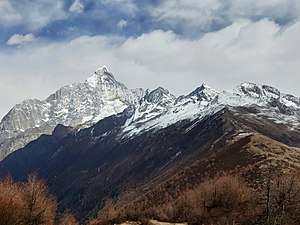Mount Siguniang
Mount Siguniang (Chinese: 四姑娘山; pinyin: Sìgūniang Shān; lit.: 'Four Girls Mountain', 'Four Sisters Mountain' or 'Four maiden's Mountain'; Tibetan: རི་བོ་སྐུ་བླ་འི། ,[3] Skubla) is the highest mountain of Qionglai Mountains in Western China. It is located in the bordering area of Rilong Town, Xiaojin County and Wenchuan County in Ngawa Tibetan and Qiang Autonomous Prefecture, Sichuan Province.
| Mount Siguniang | |
|---|---|
| རི་བོ་སྐུ་བླ་འི། | |
 From left Yaomei Feng, Sanguiang Feng, Erguniang Feng, Daguniang Feng. | |
| Highest point | |
| Elevation | 6,250 m (20,510 ft) [1] |
| Prominence | 2,571 m (8,435 ft) [2] |
| Listing | Ultra |
| Coordinates | 31°06′24″N 102°54′06″E [2] |
| Geography | |
 Mount Siguniang Location in Sichuan | |
| Location | Ngawa Prefecture, Sichuan, China |
| Parent range | Qionglai Mountains |
| Climbing | |
| First ascent | 1981 |
| Easiest route | snow/ice/glacier climb |
Mount Siguniang is renowned for its beauty. Mount Siguniang National Park was identified as a UNESCO Heritage Site as part of Sichuan Giant Panda Sanctuaries in 2006. The park comprises Mount Siguniang and the surrounding three valleys, namely Changping Valley (长坪沟), Haizi Valley (海子沟) and Shuangqiao Valley (双桥沟), covering an area of 2,000sq km.[4]
Peaks
Mount Siguniang encompasses four peaks (with 峰 meaning 'peak'): Daguniang Feng 大姑娘峰 (Big Peak or 1st peak), Erguniang Feng 二姑娘峰 (2nd peak), Sanguniang Feng 三姑娘峰 (3rd peak), and Yaomei Feng, also known as Sanzuoshan Feng 三座山峰 (3rd peak).
The highest peak is Yāomèi Fēng (幺妹峰; 'peak of the youngest sister'), also known as the "Queen of Sichuan's peaks" (蜀山皇后), standing at 6,250 m (20,510 ft). It is also the second highest mountain in Sichuan Province and the easternmost 6,000 m (20,000 ft) or higher peak on Earth. The first ascent was in 1981 by a Japanese team via the east ridge. Very few people attempt to climb this and very few of those succeed.[5] The first ascent of the southwest ridge was made in 2008 by Chad Kellogg and Dylan Johnson.[6][7]
The other three lower peaks are regular mountaineering destinations through all seasons. Mount Siguniang DaFeng (四姑娘山大峰 or 大姑娘山; 'peak of the oldest sister', 5,025 m or 16,486 ft) is normally considered as a pure trekking peak while ErFeng (四姑娘山二峰 or 二姑娘山; 'peak of the second sister', 5,276 m or 17,310 ft) and SanFeng (四姑娘山三峰 or 三姑娘山; 'peak of the third sister', 5,355 m or 17,569 ft) are more challenging, requiring basic climbing techniques.[8][9]
References
- "Yaomei Feng, China". Peakbagger.com. Retrieved 25 August 2014.
- "China III - Sichuan and Yunnan Provinces". Peaklist.org. Retrieved 25 August 2014.
- This Tibetan alphabet shown on the Ticket
- china.org.cn
- www.adventure-video.com
- Raleigh, Duane (16 February 2014). "Chad Kellogg Killed in Patagonia". Rock and Ice. Retrieved 10 April 2014.
- MacDonald, Dougald (16 February 2014). "Chad Kellogg Killed By Rockfall In Patagonia". Climbing. Retrieved 10 April 2014.
- www.dragonexpeditions.com Archived 17 July 2011 at the Wayback Machine
- www.sportsandtravel.com.hk
External links
| Wikimedia Commons has media related to Mount Siguniang. |

- Official website
- Mount Siguniang Trekking,Camping,Climbing